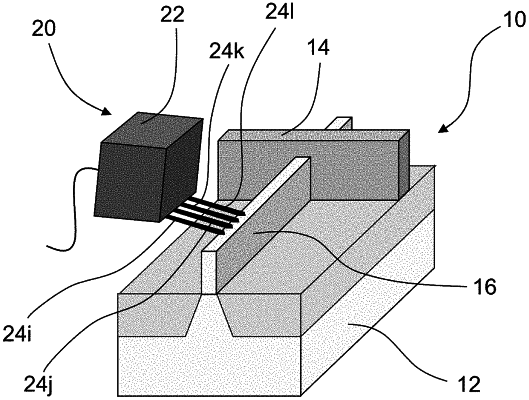| CPC G01R 31/2812 (2013.01) [H01L 22/12 (2013.01); H01L 22/14 (2013.01); H01L 22/34 (2013.01)] | 20 Claims |

|
1. A method for measuring a property in response to a temperature modulation of a test sample, said method comprising:
providing said test sample, said test sample being made of an electrically conducting or semiconducting material;
providing at least two terminals and at least two or four electrically conducting interconnections between said terminals and said electrically conducting or semiconducting material, said two or four electrically conducting interconnections contacting two or four positions at said electrically conducting or semiconducting material;
providing a power source and an electric circuit for generating a current and injecting said current into said electrically conducting or semiconducting material using said terminals;
measuring a voltage across a part of said electrically conducting or semiconducting material using said terminals;
determining said property as a function of a value of the third harmonic frequency component of said measured voltage; and
defining a threshold for accepting or rejecting said test sample.
|
|
4. A method for screening a test sample, said method comprising:
providing said test sample, said test sample being made of an electrically conducting or semiconducting material;
providing at least two terminals, and at least two or four electrically conducting interconnections between said terminals and said electrically conducting or semiconducting material;
said two or four electrically conducting interconnections contacting two or four positions at said electrically conducting or semiconducting material;
providing a power source and an electric circuit for generating a current and injecting said current into said electrically conducting or semiconducting material using said terminals;
measuring a voltage across a part of said electrically conducting or semiconducting material using said terminals;
determining a third harmonic frequency component of said measured voltage;
determining a threshold value for accepting or rejecting said test sample as a function of said third harmonic frequency component;
accepting said test sample when a magnitude of said third harmonic frequency component is lower than said threshold; and
rejecting said test sample when said magnitude of said third harmonic frequency component is higher than said threshold.
|
|
17. A method for determining the temperature coefficient of resistance, said method comprising:
providing said test sample, said test sample being made of an electrically conducting or semiconducting material;
providing a set of terminals including at least four terminals and at least four electrically conducting interconnections between said terminals and said electrically conducting or semiconducting material, said four electrically conducting interconnections contacting four positions at said electrically conducting or semiconducting material;
providing a power source and an electric circuit for generating a current;
injecting a first current into said test sample using a first combination of two terminals from said set of terminals;
measuring a first voltage using a second combination of two terminals from said set of terminals;
injecting a second current into said test sample using a third combination of two terminals from said set of terminals;
measuring a second voltage using a fourth combination of two terminals from said set of terminals; and
determining the temperature coefficient of resistance or a value proportional to the temperature coefficient of resistance as a function of said first current, said second current, said first voltage, and said second voltage.
|